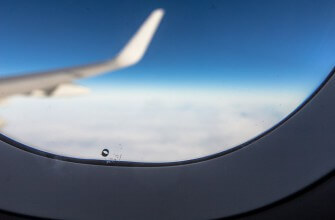1- Pilots and co-pilots can’t eat the same meal on a Flight
The practice is not mandated by the Federal Aviation Administration, however, most of the airlines make the flight crew should never, under any circumstances, be served the same meal.
While the rule may seem arbitrary, there is actually very good reasoning behind it. If, for example, something goes wrong with one meal (like food poisoning). the other pilot will not have been affected and can take over duties.
2- Weird black triangle in an aircraft cabin!
 Windows aren’t there just to give passengers a good view – they are also a safety feature.
Windows aren’t there just to give passengers a good view – they are also a safety feature.
If the crew believes there is an issue with a wing - such as a problem with the flaps, the slats or even the engines - looking out of the window may be the best way to check. And to do that they will head to the seat with the clearest view of the wing, usually marked by a small black triangle on the wall.

3- The bleed hole :
Surely You don’t have to be an aerospace engineer to know that an airplane cabin is pressurized to keep us from passing out as we soar through the skies, 11,000 meters (36,000 feet) above sea level.so we shouldn’t have holes in the windows of planes? On the contrary, those holes, which are only present in the middle pane of our triple-glazed planes, are actually there to keep us safe. Without them, passengers could be in trouble.
The air pressure inside the cabin places an enormous strain on the windows. The inside pane is largely superficial-the one you can touch and dirty up with fingerprints – is called a scratch pane.
The middle pane is the one with the bleed hole that hole actually reduces the pressure on the middle pane, so only the outer pane takes the force of the cabin pressure - and it experiences that pressure more gradually during flight. Outer pane is taking the brunt of the pressure. the most important one, since it protects you from the pressure difference outside
So that means that if the outer pane somehow was broken by debris, we'd still have the middle pane to protect us from the lack of air pressure outside. Sure, it'd have a small hole in it, but that's nothing the plane's pressurization system couldn't compensate for.
While this tiny hole plays an important role in keeping us safe, it also helps keep the window panes from fogging up – a result of the temperature difference between the inside and outside of the cabin – allowing us to stare out into the clouds.
Thank you, little weird window hole.
 4- Passenger oxygen from the chemical cocktail :
4- Passenger oxygen from the chemical cocktail :
Commercial aircraft provide emergency oxygen to passengers to protect them from drops in cabin pressure. Chemical oxygen generators are not used for the cockpit crew, who are typically supplied using compressed oxygen canisters also known as oxygen bottles. In narrow-body airliners, for each row of seats, there are overhead oxygen masks and oxygen generators. In some wide-body airliners, such as the DC-10 and IL-96, the canisters and oxygen masks are mounted in the top portion of the seatbacks, since the ceiling is too high above the passengers. If a decompression occurs, the panels are opened either by an automatic pressure switch or by a manual switch, and the masks are released. When the passengers pull down on the mask they remove the retaining pins and trigger the production of oxygen.
 5- Pointless ashtrays
5- Pointless ashtrays
Ashtrays are a surprising feature of modern aircraft. After all, smoking at 35,000 feet has been banned for around 20 years.
But why are they still there? Because if someone were to have, illegally, a cheeky fag, they’d still need to stub it out, and it's best they have somewhere to do that rather than cause a fire by dropping it in the bin. Therefore an ashtray is a mandatory requirement in most countries.
6- It's impossible to lock yourself in the bathroom
You ever notice how the flight attendants flip a little switch on the lavatory door before takeoff and landing?
That switch locks the door so it won’t fly open and can be flipped on or off at any time. So if they think you’re in there joining the mile high club or smoking a cigarette, they can catch you in.
7- Dimming the lights for takeoff and landing isn't a mood effect
Dimming the light done so passengers’ eyes can adjust to the dark, just in case there’s an emergency that shuts off the lights. That way people aren’t running around blind in sheer chaos. So almost all aviation authorities make it as mandatory in the regulation.
8- The toilets are actually vacuums
Unlike your toilet at home that siphons water down into the sewer, airplane toilets are basically vacuums: a valve opens when you flush, and the air pressure sucks what’s in the bowl down into a tank. It uses about half a gallon of water and can flush in any direction.
9- Red light on the left-wing and a green light on the right
At night, it’s hard for pilots to see other aircraft. Every plane has a red light on the left wing and green on the right, so other pilots can easily identify which way the plane is facing and what direction it’s going.
 10- Aircraft can fly with one engine, and land with none
10- Aircraft can fly with one engine, and land with none
Commercial aircraft are designed to fly with only one operable engine. And can glide their way to the ground with no engine power at all. So if your plane breaks down mid-air, you’ll still likely land in one piece!













